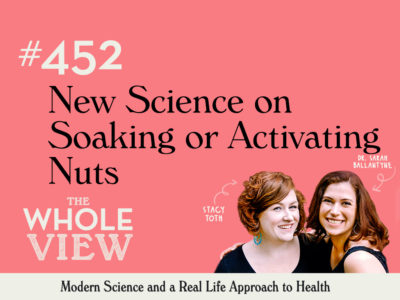On this episode of The Whole View podcast, we are straying away from our usual treats-related Halloween topic. Instead, Stacy and I discuss the science behind why some people love to be scared! We review the biology of fear behind thrill-seeking behavior, whether that’s jump scares in movies, roller coasters or base jumping. It’s a complex interaction between the amygdala, hypothalamus, HPA axis, hippocampus and prefrontal cortex!
Table of Contents[Hide][Show]
I break down the difference between the positive feelings of the adrenaline rush in the context of the rational brain (amygdala and prefrontal cortex) determining you are safe, and therefore the neurological response is simply ‘scared.’ That is in contrast to the rational brain not feeling safe, in which case the adrenal glands are signaled to add stress hormones (cortisol) into the mix, and create an unhealthy stress response! Everyone’s brains work differently, and our individual life experiences and thought processes determine our ability to rationalize safety and danger. Therefore, science can prove that different people experience the fun of being scared in different ways. That’s why some people love true crime and others love theme parks, but also why you don’t need to feel guilty for skipping out on those horror movies this year, if it means you will lose sleep or stress your body!
If you enjoy the show, please review it on iTunes!
Recommended Reading and Listening
- How Stress Undermines Health
- TPV Podcast Episode 351: Stress on Health
- Demystifying Adrenal Fatigue, Pt. 1: What Is Adrenal Fatigue?
- Demystifying Adrenal Fatigue, Pt. 2: Testing Adrenal Glandular Function
- Demystifying Adrenal Fatigue, Pt. 3: Nutrition & Lifestyle Support for the Adrenal Glands
Citations
- Steimer T. The biology of fear- and anxiety-related behaviors. Dialogues Clin Neurosci. 2002 Sep;4(3):231-49. doi: 10.31887/DCNS.2002.4.3/tsteimer. PMID: 22033741; PMCID: PMC3181681.
- Hartley CA, Phelps EA. Changing fear: the neurocircuitry of emotion regulation. Neuropsychopharmacology. 2010 Jan;35(1):136-46. doi: 10.1038/npp.2009.121. PMID: 19710632; PMCID: PMC3055445.
- Olsson A, Phelps EA. Social learning of fear. Nat Neurosci. 2007 Sep;10(9):1095-102. doi: 10.1038/nn1968. PMID: 17726475.
- Javanbakht A, Duval ER, Cisneros ME, Taylor SF, Kessler D, Liberzon I. Instructed fear learning, extinction, and recall: additive effects of cognitive information on emotional learning of fear. Cogn Emot. 2017 Aug;31(5):980-987. doi: 10.1080/02699931.2016.1169997. Epub 2016 Apr 18. PMID: 27089509.
- Koob GF. Brain stress systems in the amygdala and addiction. Brain Res. 2009 Oct 13;1293:61-75. doi: 10.1016/j.brainres.2009.03.038. Epub 2009 Mar 28. PMID: 19332030; PMCID: PMC2774745.
- Jadrić R, Kiseljaković E, Hasić S, Winterhalter-Jadrić M. Beta-endorphins as possible markers for therapeutic drug monitoring. Bosn J Basic Med Sci. 2007 Feb;7(1):11-4. doi: 10.17305/bjbms.2007.3081. PMID: 17489761; PMCID: PMC5802279.
- Boecker H, Sprenger T, Spilker ME, Henriksen G, Koppenhoefer M, Wagner KJ, Valet M, Berthele A, Tolle TR. The runner’s high: opioidergic mechanisms in the human brain. Cereb Cortex. 2008 Nov;18(11):2523-31. doi: 10.1093/cercor/bhn013. Epub 2008 Feb 21. PMID: 18296435.
- Makarowski R, Makarowski P, Kamiński Z. Adrenaline Instead of Amphetamine-Replacing Psychoactive Substances with Parachute Jumps. J Gen Psychol. 2016 Oct-Dec;143(4):281-97. doi: 10.1080/00221309.2016.1214101. PMID: 27649360.
- Heirene RM, Shearer D, Roderique-Davies G, Mellalieu SD. Addiction in Extreme Sports: An Exploration of Withdrawal States in Rock Climbers. J Behav Addict. 2016 Jun;5(2):332-41. doi: 10.1556/2006.5.2016.039. Epub 2016 Jun 27. PMID: 27348554; PMCID: PMC5387785.
- Fischer AG, Ullsperger M. An Update on the Role of Serotonin and its Interplay with Dopamine for Reward. Front Hum Neurosci. 2017 Oct 11;11:484. doi: 10.3389/fnhum.2017.00484. PMID: 29075184; PMCID: PMC5641585.
- Castanier C, Le Scanff C, Woodman T. Who takes risks in high-risk sports? A typological personality approach. Res Q Exerc Sport. 2010 Dec;81(4):478-84. doi: 10.1080/02701367.2010.10599709. PMID: 21268472.










